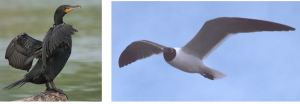Seabirds in the Gulf of Mexico are subject to multiple hazards, such as pollutants and natural toxins, including algae-produced brevetoxin. NCCOS scientists who have pioneered the measurement of brevetoxin in live animals from blood collection cards brought this method into operation with wildlife managers in Florida to support health assessment and rehabilitation. These cards were used as part of a study to be published in the April 2013 issue of the Journal of Wildlife Diseases.
The scientists used blood collection cards to help evaluate live stranded birds along the central west coast of Florida. The data showed that during a recent bloom of Karenia brevis, a brevetoxin-producing dinoflagellate, 82 percent of seabirds upon admission tested positive for brevetoxin and, of those, 64 percent died afterwards due to brevetoxicosis. Daily monitoring of blood levels of brevetoxin guided rehabilitation and release of the surviving birds by enabling a proper diagnosis and appropriate treatment.
Double-crested Cormorants (Phalacrocorax auritus) were the most commonly poisoned by brevetoxin, along with the Brown Pelican (Pelecanus occidentalis), Great Blue Heron (Ardea herodias) and Laughing Gulls (Larus atricilla). However, 19 percent of birds also tested positive when a toxic bloom or ‘red tide’ was not occurring, which shows that there can be long term health risks to seabirds in this area, and points to a need for monitoring of brevetoxin levels.

The use of blood collection cards, a Center for Disease Control (CDC) method for blood collection and sample archiving, was developed by NCCOS for biomonitoring brevetoxin exposure in humans and wildlife species, including sea birds, sea turtles, manatees and dolphins. The blood card method used as part of this study could be a reliable means of monitoring brevetoxin levels to assess wildlife mortality events in the Gulf of Mexico, as well as to establish “baseline” levels during non-bloom periods.
Contributing partners in this study includeMote Marine Laboratory, Florida Fish and Wildlife Conservation Commission, Pelican Man’s Bird Sanctuary, the University of Illinois Zoological Pathology Program and the Wildlife Health Center of University of California, Davis. The Morris Animal Foundation funded this research.
Publications

- See also: Biomonitoring Brevetoxin Exposure in Mammals Using Blood Collection Cards and Optimization of Blood Collection Card Method/Enzyme-Linked Immunoassay for Monitoring Exposure of Bottlenose Dolphin to Brevetoxin-Producing Red Tides.
- Deep background: Karenia brevis red tides and brevetoxin-contaminated fish: a high risk factor for Florida’s scavenging shorebirds?
Products
- Blood Cards: NOAA scientists develop blood collection cards that provide new on site technology for harmful algal bloom rapid response
- Toxin Test Kit: The detection of brevetoxin from the blood collection cards used in this study was accomplished by an enzyme linked immunosorbant assay, developed by NCCOS and AgResearch (New Zealand), and which is available commercially as a test kit by Abraxis (Warminster, PA). This ELISA has been used to successfully detect brevetoxins from a wide variety of wildlife including seabirds, turtles, dolphins and other marine mammals.
